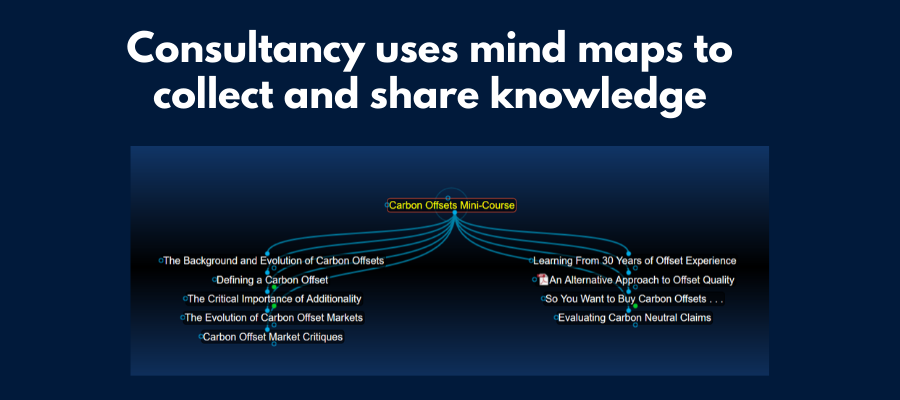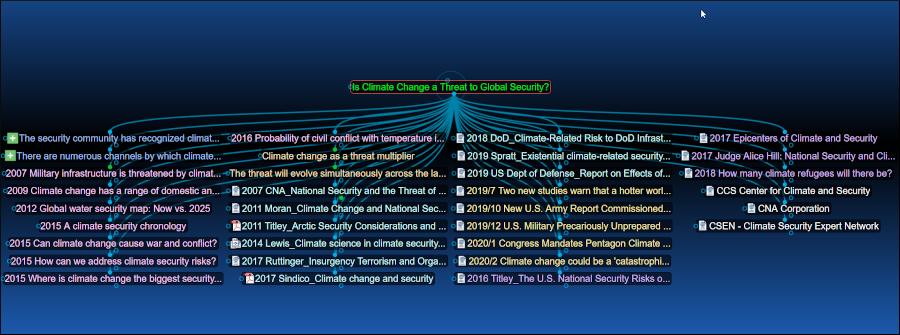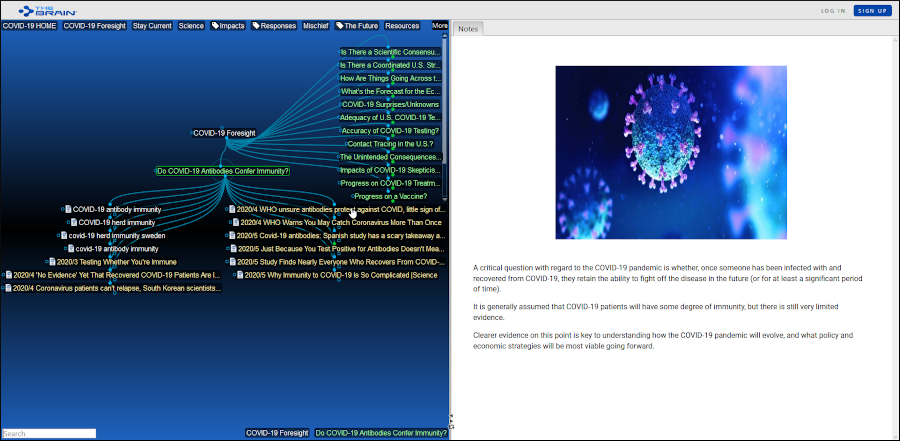
One application of mind mapping tools that doesn’t get as much attention as it should is utilizing it to capture, organize and share collections of knowledge. One organization that has made tremendous strides in this area is a consultancy called The Climatographers, which advises corporations on climate change. It’s using a mind mapping tool called TheBrain to share collections of knowledge and training on this important topic via its Your External Brains website.
I recently interviewed the founders of The Climatographers, Dr. Mark C. Trexler and Laura Kosloff, to learn more about this fascinating project.
Chuck Frey: Please tell me a bit about your business, the Climatographers? What do you do? What types of services do you provide?
Mark Trexler & Laura Kosloff: The Climatographers do corporate advisory work around climate change. We’ve worked with companies on climate change for decades and have a long series of firsts in the space. First carbon footprints, first carbon offsets, first carbon price modeling. We launched the first U.S. advisory firm focused on managing the climate risk of companies in 1991. There are lots of things we can do with companies today, but we’re primarily focused on climate risk knowledge management and scenario planning.
Frey: How did this lead to the idea of using TheBrain for knowledge capture and organization?
Trexler & Kosloff: We’ve always been interested in knowledge management and used mind maps before there were any mind mapping software: Mark to map out his doctoral thesis defense and Laura to prepare for the bar exam. We’ve used numerous knowledge software over the decades and started working with TheBrain more than 15 years ago.

Frey: Please describe the defining moment, the trigger that made you decide “we need to do this!“
Trexler & Kosloff: What’s different about our work with TheBrain over the last 10 years is our focus on building Brains that could be used by other people. Mark was attending a big business conference in New York 2011 and heard the authors of a book titled “Influencer – How to Change Anything” talk about their research into human decision-making. As they described the conclusions of their work, Mark realized 1) the relevance to our management consulting work, and 2) how useful TheBrain could be in organizing the massive amount of information needed to provide decision-makers with “actionable knowledge.”
We started building the Climate Web the next week, and today it is the closest thing to a collective climate change intelligence that exists, and the largest topical Brain in existence.
In working with the Climate Web, we’ve had a lot of difficulty getting people to spend the time coming up the relatively short learning curve needed to use the Climate Web. People are terrified of how much information is in there, and don’t like the interface. That’s why we started thinking about mini-brains, and launched our External Brains website. www.yourexternalbrains.com
Frey: What do these mini-brains contain? Are they primarily a curated collection of links to articles, white papers and other resources?
Trexler & Kosloff: Mini-brains contain different things, including curated links to articles, videos, books, news stories, and more. But some of them also contain mini-courses, intended to help bring people up to speed on key topics quickly. But all mini-brains are kept very simple to try and overcome people’s reaction to TheBrain interface. As a result, anyone can take advantage of our various External Brains.
We also have “intermediate” brains, including our Your Climate Change PhD and Your Climate Change MBA, both organizing very large amounts of information, but not nearly all of the information in the Climate Web. In fact, we point people to curated collections in the Climate Web for hundreds of climate change topics rather that replicating all of that information in these intermediate Brains.
Frey: Why use TheBrain to present these knowledge collections?
Trexler & Kosloff: Because it’s the tool we’re focused on, and because it is so easy to change everything around in TheBrain to experiment with different ways of organizing information to see whether that makes it easier for people to take advantage of. Some of our simplest mini-brains could be built with a mind mapping software, but all of our External Brains organize a whole bunch of mini-brains. It would be impossible to get all of that into a conventional mind map. TheBrain is of course a mind-mapping software, but its 3D nature fundamentally differentiates it.
Frey: Is it an advantage that TheBrain enables subscribers to view these mini-brains in a visual format, even though they don’t own a licensed copy of TheBrain?
Trexler & Kosloff: Anyone can access the mini-brains on-line, but we urge people to take advantage of the free TheBrain software to download the mini-brains to their computers or mobile devices. TheBrain laptop and even mobile device software, even the free versions, are vastly superior to accessing the mini-brains on line. And that’s why we’re trying to build a business model through Patreon – based on allowing people downloadable access to the Mini-Brains as a much superior alternative to on-line access.

Frey: Who are these mini-brains for? Who can benefit from them?
Trexler & Kosloff: We have a simple climate change External Brain, a core knowledge External Brain (the idea being to organize the knowledge that anyone should know), an energy and environment External Brain, a Type II Diabetes External Brain, a High School Exchange External Brain and a COVID-19 External Brain. Sp there’s an External Brain for almost anyone. We do a weekly “COVID-19 foresight video” using the COVID-19 External Brain.
Frey: Are these mini-brains designed so that people who download them can customize them and add to them?
Trexler & Kosloff: People can download the External Brains on a read-only basis through our Patreon Project for $5/month for one Brain, and $10/month for all the External Brains (not PhD, MBA, or Climate Web). That way they get the benefit of downloading them, and the benefit of staying current with all the work we continue to do on them so they stay synced.
People can also purchase the External Brains for different prices from $49 to $99 if they want to customize a Brain for their own purposes. In that case they don’t get the advantage of our continued work since the Brains are entirely under their control.
Frey: What types of responses have you gotten from this audience about your mini-brains?
Trexler & Kosloff: It’s still challenging to get people to really explore the External Brains. We’ve sold a number of them (mostly to established TheBrain users), and the same goes for our Patreon project. We’re a lot better at building the External Brains than marketing them, and we’re still experimenting on how to do that. One approach we’re using is a whole series of free e-books that we’ve built to help people explore climate change topics. Available at both our Climate Web and Climatographer websites.
Frey: How do you decide what climate-related topics to focus on?
Trexler & Kosloff: For our smaller External Brains we focus on things we think a lot of people will be interested in. Carbon offsets, individual action on climate change, communicating climate change, etc. The Climate Web covers pretty much the entire topic of climate change (not so much the hard science). People can investigate hundreds of climate topics and take advantage of the 20,000 hours of knowledge curation that have gone into the Climate Web.
Frey: Are there some topics that don’t lend themselves very well to being explored in this type of visual format?
Trexler & Kosloff: It’s really a matter of whether people are willing to use a tool like this one – as opposed to being a content-related issue. People who just aren’t visual learners are unlikely to be interested. And people who just can’t make computers work tend to get lost pretty quickly.
Frey: What is it you like about TheBrain as a tool for capturing and organizing knowledge?
Trexler & Kosloff: How easy it is to add information, how easy it is to modify and reorganize information, and the fact that there are no limits to the amount of information. We’re not trying to market “pretty mind maps” as some others are, we’re trying to help people manage knowledge, and access knowledge they wouldn’t otherwise access.
Our climate change work is intended to help solve climate change, since we’ve come to realize over the years that climate change is ultimately a communications problem. There’s infinite information out there, but very few people ever see the “actionable knowledge” that would really influence their thinking and actions. And because TheBrain is so easy to reorganize, we can plausibly organize information one way for individuals, one way for business, one way for teachers, etc. Really tough to do that with other types of software.
Frey: What is your goal in providing these to anyone who wants them? Do you hope to find new clients from this initiative?
Trexler & Kosloff: We’re hoping people will sign up to our Patreon project, and or need our business advisory support.
Frey: What else should readers of the Mind Mapping Software Blog know about this project?
Trexler & Kosloff: That to our knowledge it’s a unique effort. While a huge number of people use TheBrain for their personal knowledge management, you can count the number of people trying to deliver knowledge to others through TheBrain on the fingers of two hands.
And no one is focused on trying to tackle a wicked problem like climate change through a knowledge management software. Readers can leverage hundreds of hours of knowledge curation through our various External Brains, and 20,000 hours of knowledge curation through our flagship Climate Web (and Your Climate Change PhD and MBA products). And we can build customized Brains.
Frey: Where can they learn more?
Trexler & Kosloff: They can access our External Brains at the External Brains website. If they’re interested in climate change, they should also visit the Climateweb website and if they’re looking for advisory support, visit The Climatographers website

Leave a Reply